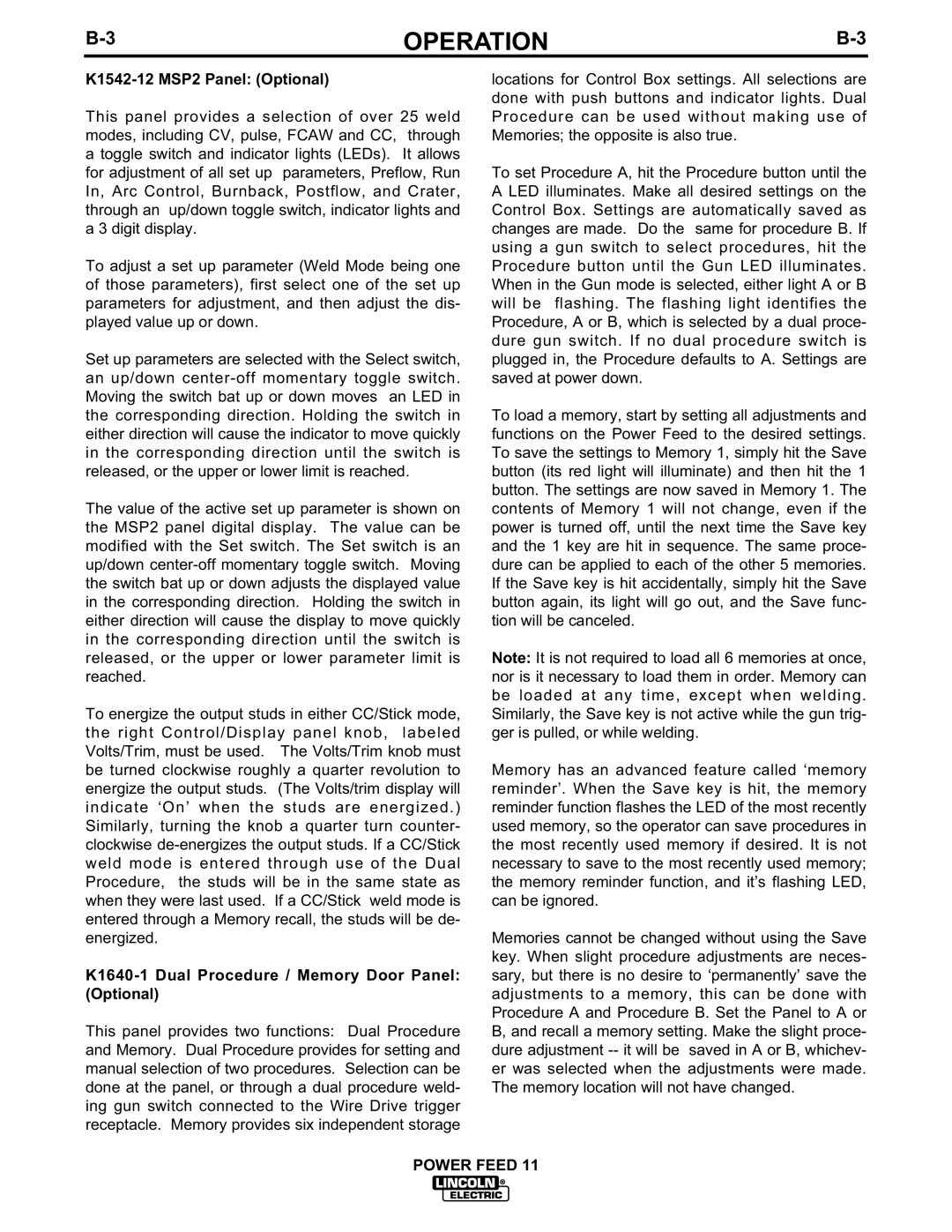OPERATION | ||
|
|
|
K1542-12 MSP2 Panel: (Optional)
This panel provides a selection of over 25 weld modes, including CV, pulse, FCAW and CC, through a toggle switch and indicator lights (LEDs). It allows for adjustment of all set up parameters, Preflow, Run In, Arc Control, Burnback, Postflow, and Crater, through an up/down toggle switch, indicator lights and a 3 digit display.
To adjust a set up parameter (Weld Mode being one of those parameters), first select one of the set up parameters for adjustment, and then adjust the dis- played value up or down.
Set up parameters are selected with the Select switch, an up/down
The value of the active set up parameter is shown on the MSP2 panel digital display. The value can be modified with the Set switch. The Set switch is an up/down
To energize the output studs in either CC/Stick mode, the right Control/Display panel knob, labeled Volts/Trim, must be used. The Volts/Trim knob must be turned clockwise roughly a quarter revolution to energize the output studs. (The Volts/trim display will indicate ‘On’ when the studs are energized.) Similarly, turning the knob a quarter turn counter- clockwise
K1640-1 Dual Procedure / Memory Door Panel: (Optional)
This panel provides two functions: Dual Procedure and Memory. Dual Procedure provides for setting and manual selection of two procedures. Selection can be done at the panel, or through a dual procedure weld- ing gun switch connected to the Wire Drive trigger receptacle. Memory provides six independent storage
locations for Control Box settings. All selections are done with push buttons and indicator lights. Dual Procedure can be used without making use of Memories; the opposite is also true.
To set Procedure A, hit the Procedure button until the A LED illuminates. Make all desired settings on the Control Box. Settings are automatically saved as changes are made. Do the same for procedure B. If using a gun switch to select procedures, hit the Procedure button until the Gun LED illuminates. When in the Gun mode is selected, either light A or B will be flashing. The flashing light identifies the Procedure, A or B, which is selected by a dual proce- dure gun switch. If no dual procedure switch is plugged in, the Procedure defaults to A. Settings are saved at power down.
To load a memory, start by setting all adjustments and functions on the Power Feed to the desired settings. To save the settings to Memory 1, simply hit the Save button (its red light will illuminate) and then hit the 1 button. The settings are now saved in Memory 1. The contents of Memory 1 will not change, even if the power is turned off, until the next time the Save key and the 1 key are hit in sequence. The same proce- dure can be applied to each of the other 5 memories. If the Save key is hit accidentally, simply hit the Save button again, its light will go out, and the Save func- tion will be canceled.
Note: It is not required to load all 6 memories at once, nor is it necessary to load them in order. Memory can be loaded at any time, except when welding. Similarly, the Save key is not active while the gun trig- ger is pulled, or while welding.
Memory has an advanced feature called ‘memory reminder’. When the Save key is hit, the memory reminder function flashes the LED of the most recently used memory, so the operator can save procedures in the most recently used memory if desired. It is not necessary to save to the most recently used memory; the memory reminder function, and it’s flashing LED, can be ignored.
Memories cannot be changed without using the Save key. When slight procedure adjustments are neces- sary, but there is no desire to ‘permanently’ save the adjustments to a memory, this can be done with Procedure A and Procedure B. Set the Panel to A or B, and recall a memory setting. Make the slight proce- dure adjustment
